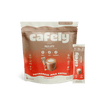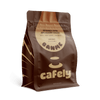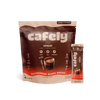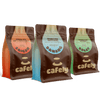From how it's brewed in the cezve (a small, long-handled coffee pot) to the order in which it's portioned, Turkish coffee is steeped in tradition. This tradition is quite the opposite of today’s fast-paced world, one of slow brewing and gradual savoring.
Let’s dive into this excellent drink and discuss how best to enjoy it.
How to Drink Turkish Coffee
Turkish coffee is served in small cups called “fincans.” These cups are enough to hold one portion — roughly 65 mL, slightly more than a double espresso. Though this might seem like a small portion, you should sip Turkish coffee slowly, savoring the flavors.
Before you raise the cup to your lips, give it a few minutes for the finely ground coffee to settle to the bottom of the cup. After it settles, sip your Turkish coffee for over ten minutes or so. Traditionally, Turkish coffee is served with a glass of cold water — a palate cleanser between sips.
The final thing to consider is that you shouldn’t drink the whole thing. The fine coffee grounds sit at the base of your fincan. You’ll want to avoid taking the last sip, ending up with a mouthful of unpleasant grounds.
How To Brew Turkish Coffee — A Step-by-Step Guide
Brewing Turkish coffee can seem complex and daunting, especially when considering its tradition and history. However, it can be brewed in your home to create a truly potent and flavorsome experience.
Here’s a step-by-step guide to making a delicious drink:
Ingredients & Tools:
- Finely ground Turkish coffee (1 tsp per portion) — Aim for a grind consistency similar to powdered sugar.
- Cold water (0.5 cups of water per portion) — “Cups” refers to the fincan cup you’ll be drinking from. Using cold water can reduce the bitterness of the coffee.
- Sugar (optional) — You can add sugar or natural sweeteners during the brewing process if desired.
- Cezve or Ibrik — This is the traditional Turkish brewer, a metal pot with a long handle to prevent you from burning yourself. “Cezve” is the Turkish name, and “Ibrik” is more commonly used across the Middle East.
- Heat — While hot sand is a traditional heating method that you’ve likely seen on social media, you can also use low heat on a stove.
Method/Instructions:
- Add the ingredients to your cezve. Add one heaping teaspoon of coffee and one and a half cups of water per serving and any sugar you might be using.
- Combine the mixture in the cezve with a spoon or stirring implement. You will not stir the coffee while it is on the stovetop, so be sure to mix it well beforehand.
- Place the brewer over low heat and bring it to the beginning of a boil. This should take around three or four minutes. Keep it at this heat for a little while, and the mixture will begin to develop an aromatic dark foam on top.
- Continue the low simmer for seven to ten minutes before serving. Portion out the foam first, dividing it equally among everyone who’s drinking. Then, decant any remaining coffee into the cups.
Common Mistakes in Brewing Turkish Coffee

Making Turkish coffee may seem simple, but there are quite a few ways that people often make small mistakes that impact the brew.
Here are some common mistakes and how you can avoid them:
- Grinding Too Coarsely — Traditional Turkish coffee brewing uses extra-finely ground coffee. Most home grinders can't achieve the powder-like consistency required. Make sure to use a high-quality burr grinder or opt for pre-ground Turkish coffee.
- Over-Boiling — If you allow the coffee to get too hot, you’ll end up with a bitter, strong brew. The first sign of rough boiling is your cue to remove it from the heat.
- Stirring During Brewing — When coffee is brewing in a cezve, a convection current naturally forms since the coffee is hottest at the bottom of the brewer. Therefore, the coffee’s already being well mixed with the brewing water, and stirring with a spoon is overkill at best, or can lead to clumps (and therefore uneven extraction) at worst.
- Over-sweetening — Avoid adding too much sugar to your brew. While strong coffee is nicely balanced by sweetness, adding too much sugar can mask the delicate flavors of the drink. Try pairing the dark, bitter coffee with a sweet food or drink on the side: the two can balance each other, helping you enjoy them both more.
How to Enhance Your Turkish Coffee
Turkish coffee is a complex drink, but this doesn’t mean that you can’t alter the traditional recipe. Here, we’ve got some great ways that you may be able to enhance the drink at home.
What Coffee To Use
Turkish coffee is made with extremely finely ground coffee, so you may opt for a coffee roasted to a very dark level. These dark roast beans are commonly used for fine grinding to make espresso because they tend to have a more consistent texture.
If you’re opting for an extremely dark roast, you may be best served by robusta coffee beans. These beans are roasted dark to ensure their sweetness is gently coaxed out, leading to a complex, earthy flavor in skillfully produced coffee.
Altering Your Brew
Changing things while you brew can alter the flavors in your cup in several ways. This is why baristas will often speak of "dialing in" their espresso machine first thing in the morning. Getting the best coffee out of the machine often relies on taking the time to ensure that your grind size, water temperature, and pressure levels are all working in tandem.
A good starting point for altering a traditional recipe for Turkish coffee is to mix up the temperature of the brewing water that you add to your cezve. Cold water is traditionally added to the coffee grounds, but you could experiment with adding hot water instead. Doing this with hot water could lead to a pre-infusion period, where you dissolve some interesting tasting notes from the coffee.
Food & Drink Pairings
Traditionally, Turkish coffee is served with a glass of cold water to give your palate a nice cleanse before each new sip. You can change that out to sparkling water or something similar, though substituting with a sweet juice isn’t a great idea.
For food pairings, this beverage is often served with small, sweet treats like Turkish delight and baklava. Any sweet snack will pair well with coffee. But sometimes, savory works too. Simit, a sesame-crusted bread, is a great snack with coffee. Dolma (stuffed vine leaves) are another popular item.
The History of Turkish Coffee
Coffee first made its way to Turkey in 1543. It was brought to the country by Özdemir Pasha — the Ottoman governor of Yemen. After trying the beverage in Yemen, he decided to bring the drink back with him along with the Arabic brewing technique. His love of the drink would prove contagious, and it spread through the country rapidly.
With its rise in popularity, a whole industry sprang up around the beverage, with the first coffee shops opening in 1554, only eleven years after the beans first arrived in the country. People would frequent these cafes for thoughtful debates, conversation, and socialization while enjoying stellar coffee.
As history proceeded, Istanbul became a thriving center for trade and industry at the heart of the Ottoman Empire. Millions of merchants from across the empire and beyond came to it to meet and trade, and many of these people tried and loved coffee.
In a sense, they followed in the footsteps of Özdemir Pasha — they took coffee home with them. Coffee and its unique brewing process became a social ritual throughout the Ottoman Empire, leading to its widespread acceptance.
The Traditions That Accompany Turkish Coffee

The first tradition you may experience is the serving order. As a sign of respect, the host serves coffee to the eldest person first. The pourer starts with the foam sitting on top of the brew, then tops everyone’s cups with the remaining coffee. This foam — similar to the crema on an espresso — forms during brewing and is a prized part of the final beverage.
While having coffee and a catch-up is a common social event across the world, drinking coffee has also been a form of socialization in Turkish society. Because the brewing process takes time and care, especially with the decanting ceremony and waiting for the grounds to settle, it provides time for people to catch up and socialize.
Tasseography (reading tea leaves or coffee grounds) is also a core part of Turkish coffee culture. The craft of predicting the future itself is matrilineal, with mothers passing it to their daughters. At every table, the person reading the coffee grounds in the cup is called “falci” — literally, “fortune teller.”
While sipping coffee or waiting for the grounds to settle before your fortune was told, you may have indulged in food. Turkey has lots of delicious traditional food — both sweet and savory — that are paired with coffee. Some classic sweet options include Turkish delight and baklava.
FAQs: How to Drink Turkish Coffee

Now that we’ve shared some fascinating information about the world of Turkish coffee, let's examine some FAQs..
1. How to Drink Turkish Coffee Correctly?
After the coffee has been served, it’s essential to allow a few minutes for the grounds to settle to the base of the cup. Then, sip the coffee slowly to savor the indulgent flavor and mouthfeel that the unique brewing method offers.
2. Are You Supposed to Drink the Powder in Turkish Coffee?
No, the powder at the bottom of a cup of Turkish coffee is coffee grounds, and it shouldn’t be drunk. While safe to do so, it’s unlikely to have a very pleasant flavor.
3. How Do Turkish People Drink Their Coffee?
Probably to no one’s surprise, Turkish coffee is very popular in Turkey. Even as Western-style coffee shops become more popular, the art of brewing in a cezve and drinking slowly while socializing is very common.
4. Do You Add Milk to Turkish Coffee?
While you can add anything you might like to Turkish coffee, it’s not common to add milk to the drink. One of the main reasons for this is that as the beverage is stirred to mix in the milk, the grounds are disturbed, leading to a silty mouthfeel.
5. What Is the Disadvantage of Turkish Coffee?
Perhaps the primary disadvantage of Turkish coffee is that the drink is intensely caffeinated. The fine grind size ensures a very high level of extraction, both in flavor and the caffeine content of the grounds. Some people find the intense flavor and caffeine hit a little too intense.
6. What Is So Special About Turkish Coffee?
Turkish coffee is rare in many ways. Principally, it is served unfiltered. In addition, it's one of the few brewing methods that actively encourages you to boil the water — most other brewing methods use water that's just off the boil.
7. What Time Should I Drink Turkish Coffee?
There are no specific rules around the best times to drink your Turkish coffee, but because of the high caffeine content, you may be best served by drinking the coffee in the morning.
8. How Can I Make Turkish Coffee Less Grainy?
Turkish coffee is served with the coffee grounds still in the cup. To prevent the grounds from getting into your mouth, leave the cup on the table for a minute or two after pouring. This will ensure the grounds settle to the bottom of the cup.
9. Is Turkish Coffee Stronger than Regular Coffee?
Turkish coffee is stronger than regular black coffee per milliliter but not per portion. One serving of the Turkish drink is typically just over 2 oz (60 mL). That portion will typically have fifty to sixty-five mg of caffeine. A cup of regular drip coffee typically contains 95 mg of caffeine, but it will be four times the size, at around 8 oz, or 240 mL.
10. Why Was Coffee Illegal in Turkey?
Coffee was briefly illegal in Turkey because of its caffeine content and stimulant nature. The rulers at the time considered it more of a drug than a drink, outlawing it. However, this ban was eventually overturned.










